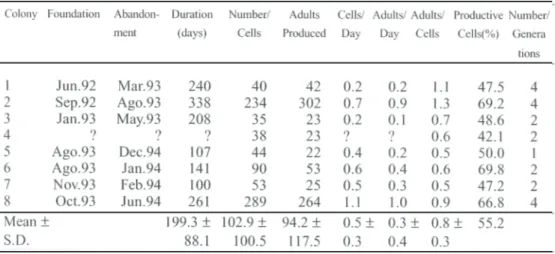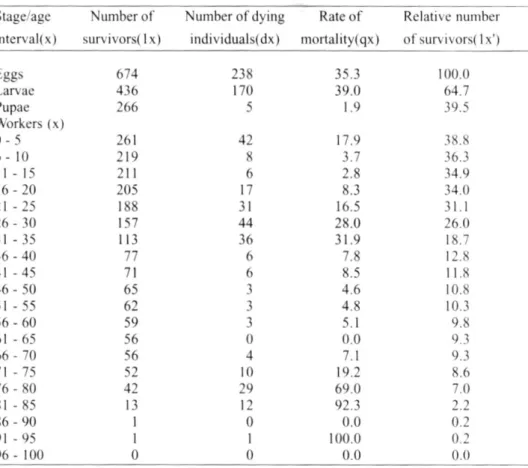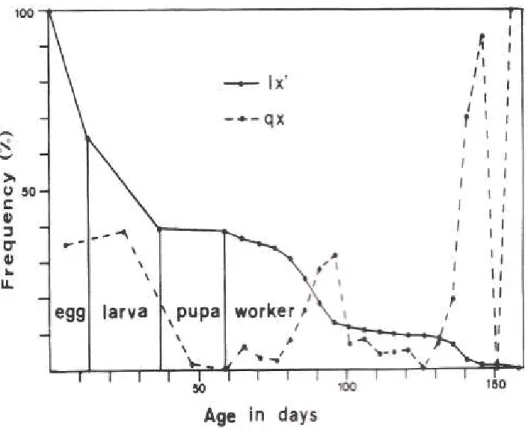Biology of the Wasp
Polistes (Epicnemius) cinerascens
Saussure
(Hymenoptera: Vespidae)
Edilberto Giannotti1
1Departamento de Zoologia e Centro de Estudos de Insetos Sociais, Instituto
de Biociências, Universidade Estadual Paulista, Caixa postal 199, 13506-900, Rio Claro, SP.
An. Soc. Entomol. Brasil 26(1): 61-67 (1997)
Biologia da Vespa Polistes (Epicnemius) cinerascens Saussure (Hymenoptera: Vespidae)
RESUMO - Estudos dos ninhos da vespa social Polistes (Epicnemius) cine-rascens Saussure apresentaram correlação entre o tamanho do favo e a largura do pedúnculo, bem como com a altura das células e número de gerações pro-duzidas. Foi verificado o tempo de duração do ciclo biológico das colônias (199,3 dias), número de células construídas (102,9) e de adultos produzidos (94,2), além das taxas: 0,5 células/dia, 0,3 adultos/dia e 0,8 adultos/célula, da percentagem de células produtivas/ninho (55,2 %) e do número de gerações/colônia (até 4). O número de ínstares larvais foi 5, a taxa de crescimento 1,3, o tempo de duração dos estágios imaturos foi: ovos = 13,0 dias, larvas = 23,7, pupas - 22,2 e a duração total = 58,6 dias. A longevidade dos adultos foi 38,3 dias.
PALAVRAS-CHAVE: Insecta, ciclo colonial, estágios imaturos, longevidade, tabela de vida.
ABSTRACT - Studies on nests of the social wasp Polistes (Epicnemius) cine-rascens Saussure showed correlation between the size of the comb and thick-ness of the peduncle, besides of the height of the complete cells and the number of generations produced. The duration of the colony cycle (199.3 days), the number of cells built (102.9) and adults produced (94.2) allowed to establish the rates: 0.5 cells/day, 0.3 adults/day, and 0.8 adults/cell, the % of productive cells/ nest (55.2), and the number of the generations/colony (up to 4 generations). The number of instars was 5; the growing ratio1 .3; the duration of the immature sta-ges was eggs = 13.0 days, larvae = 23.7, pupae = 22.2 and total duration = 58.6 days; and the longevity of adult wasps = 38.3 days.
KEY WORDS: Insecta, colony cycle, immature stages, longevity, life table.
The Neotropical species of Polistes have been poorly studied and the biology of many Brazilian species remains unknown. There are 206 recognized species of Polistes (including the three socially parasitic species of Sulcopo-listes) distributed throughout the world (Reeve
1991). According to Richards (1978), there are 84 species in the Americas, 39 of which occur in Brazil.
geogra-phic distribution: Argentina, Uruguay, Para-guay, Bolívia, Equador and Brazil (South, Southeast, Central and Northeast regions). The nests were described as small grayish combs, comprising from 5 to 29 cells (com-plete cells were 18 mm height and 4.5 mm wide), with a shining black eccentric peduncle (4 mm long); the cocoon-caps were white or grayish and flat (Richards 1978). In spite of this large occurrence, its biology is unknown.
This study was conducted on the biology of P. cinerascens, including the nest archi-tecture, colonial life cycle and productivity, brood development and adult lifespan, to pro-vide a life-table and a survivorship curve of its population.
Material and Methods
Field studies were carried out in the cam-pus of the Universidade Estadual Paulista, at Rio Claro (22°24' S, 47°33' W, altitude 612 m), São Paulo State, Southeastem Brazil, from January, 1993 to June, 1994. Seven nests of P. cinerascens were mapped daily in different colonial stages of development (pre, post-emergence, and decline) with the purpose of studying the development of immature stages and observing the brood loses. Adults were individually marked on the thorax with dots of model airplane enamel for determining their lifespan and for verification of their hierarchi-cal position in the colony. A life-table and a survivorship curve for brood and adult wasps were built, according to Silveira-Neto et al. (1976).
Abandoned nests were collected, dissec-ted and measured (using a caliper) in the fol-lowing structures: length and thickness (at the widest and narrowest points) of the pedun-cle, length and width of the comb, height and width (space between two parallel walls) of the complete cells, and the height of the meco-nial layers in the floor of the cells. Eggs, larvae and pupae of two colonies were fixed in Die-trich solution for 48 h and preserved in 70% ethyl alcohol for studies on nest architecture
and morphology. Ten immatures of each stage, were measured under stereomicroscopy fit with a reticule, and the number of instars deter-mined according to the width of the cephalic capsules. The approximated foundation date of the colonies 1, 2,6,7, and 8 was estimated by counting the number of meconial layers times the mean duration of the brood development.
Results and Discussion
The nests of P. cinerascens were built un-der leaves of Sabal maritima (Palmae) (n = 3), Attalea exigua (Palmae) (n = 1), Bambusa metake (Gramineae) (n = 1), Rhododendron indica (Ericaceae) (n=l), and Agave angus-tifolia (Amaryllidaceae) (n = 1), at 1.76 ± 0.37 m high from the ground level. The nest eccen-tric peduncle was 5.9 ± 1.0 mm long and its thickness was 1.5 ± 0.9 mm at the narrowest point and 2.2 ± 1.3 mm at the widest point. The comb measured 52.2 ± 26.8 mm at the wi-dest point and 58.3 ± 30.4 mm at the longest point. There was a high correlation between the number of cells and peduncle thickness (Spearman coefficient rs = 0.58, at the narro-west point, and rs = 0.84, at the widest point), confírming that the peduncle was enlarged as the comb grew. The height of the complete cells showed a significant variance (F = 64.5, P < 0.001) according to the number of genera-tions reared therein. Cells used to rear one generation were 17.3 ± 1 .2 mm (n = 83) height;0 two 18.5 ± 1.3 mm (n = 50); three 20.2 ± 1.3 mm (n = 34); and four generations were 22.5 ± 2.4 mm (n = 15) height. The width of the complete cells did not vary significantly according to the number of generations (F = 2.3, P > 0.05), and the mean width of the cells was 4.8 ± 0.2 (n = 182). There was a high correlation between height of the meconial layer in the cells and height of the cells (rs = 0.76), confirming the cells were lengthened according to the number of generations.
cycle is asynchronous in relation to months of the year, so that, nest foundations, active nests and abandonments were observed throughout the year. These results agree with those reported by other authors about the colony cycle of social wasps in tropical re-gions (West-Eberhard 1969, Jeanne 1972, Gobbi & Zucchi 1980, Simões & Mecchi 1983, Yamane 1986, Gobbi & Simões 1988, Giannotti & Machado 1994c).
Colony 3 was haplometrotic but the Co-lony 5 had a initial pleometrosis showing from 4 to 8 foundresses during the pre-emergency stage. Colonies 3, 5, 6 and 7 originated by foundresses proceeding from the Colony 2, and nests were built in the same plant or in the neighborhood (up to 7 m distant). A num-ber of papers suggested that there is a tenden-cy of sisters to found new nests together and near the parental colony (West-Eberhard 1969,
Table 1. Biological parameters o f Polistes cinerascens, obtained in the field at Rio Claro, SP, from January, 1993 to June, 1994.
Klahn 1979, Shellmann & Gamboa 1982, Post & Jeanne 1982, Pfenning et al. 1983, Giannotti & Mansur 1993). The pre-emergence stage of the Colony 5 lasted 67 days (egg substage 20 days, larval substage 26 days and pupal subs-tage 21 days). The duration of the pre-emer-gence stage of Polistes versicolor (Olivier) is 86.2 ± 5.8 days (Giannotti & Mansur 1993) and of Polistes lanio lanio (Fabricius) is 76.9 ± 19.53 days (Giannotti & Machado 1994c), both longer than that of P cinerascens.
The duration of the colony cycle of P. cine-rascens was variable, from 100 to 338 days, and the total mean duration was 199.3 days (Table 1). There are three other Brazilian
Table 2. Life table of brood and workers of Polistes cinerascens from seven colonies studied in Rio Claro, from January, 1993 to June, 1994.
number of cells of 102.9 and 177.0 (Gobbi et al. 1993), respectively. The number of cells produced by P. simillimus is much greater (391.3 cells), but it reutilize the comb cells only for the 2nd generation (Gobbi et al. 1993). The nest utilization strategy of P. lanio lanio is very different than other species. It builds large and polydomic nests (259.6 cells, so that each comb contain 101.3 cells) and reutilize the comb cells for up to fíve generations (Giannotti & Machado 1994c).
Colonies of P. cinerascens produced a mean of 94.2 adults, 0.5 cells/day, 0.3 adults/ day, and 0.8 adults/cell (Table 1). Most of the-se values were smaller than that verified for P.
versicolor colonies (Gobbi & Zucchi 1985): 148.3 adults, 1.4 cells/day, 0.9 adults/day, and only the ratio 0.6 adults/cell was higher in P. cinerascens. These data suggest that colonies of P. versicolor are more productive than P. cinerascens.
Figure 1 - Survivorship (lx’) and rate of mortality (qx) curves of immature stages and workers of Polistes cinerascens.
larvae was 1.34, in agreement to the Dyar’s rule. The width of the pupal head was 3.6 ± 0.1 mm. The duration of the immature stages had the following average times: eggs 13.0 ± 2.8 days (n=252), larvae 23.7 ± 4.2 days (n = 161), and pupae 22.2 ± 3.4 days (n = 196). The total duration, from egg to adult, was 58.6 ± 5.6 days (n = 79). The duration of immature stages for other Neotropical species of Polistes are: P. erytrocephaius Latreille egg 17.1, larva 26,6, pupa 23.8, total 67.5 days (West-Eberhard 1969), P. versicolor egg 10.0, larva 20.9, pupa 18.4, and total 49.4 days (N. Gobbi personal information), P. lanio lanio egg 20.8, larva
40.6, pupa 22.6, and total 87.3 days (Giannotti & Machado 1994a), and P. simillimus egg 10.2, larva 25.3, pupa 18.7, and total 51.9 days (E. Giannotti, unpublished data). These data sug-gest that besides some ecological features like local climate, food available, foraging efficien-cy, predator and parasitoid occurrences, whi-ch could affect every immature stage develop-ment, the pupal stage is very similar in all this Neotropical species.
days, and it could vary among colonies, accor-ding to local temperature, and method of observation. The life-span of workers of the Neotropical wasp P. versicolor varied from 10.8 to 17.6 days in four colonies (N. Gobbi personal information), of P. lanio lanio from 22.3 to 44.7 in 8 colonies (mean 28.3 days) (Giannotti & Machado 1994b), and the average longevity of workers of P. simillimus was 29. 1 days (E. Giannotti, unpublished data).
The life table (Table 2) and the survivor-ship curve (Fig. 1) of immatures and adults of P. cinerascens showed a rate of mortality of 35.3 for the egg stage, 39.0 for larval stage and only 1.9 for pupal stage. Oophagic beha-viors are performed by the adults either to maintain their hierarchical position (differential oophagy), eating the eggs newly laid by the other nest mates, or for nourishment (nutritio-nal oophagy) (Gervet 1964). Main cause of larval losses in social wasps is the larviphagy, that generally occurs under unfavorable cli-matic conditions as a form to substitute the foraging activity of the workers. Eggs and larvae in the peripheries of the comb cells are eaten rather than those in the center of the comb. Because of this high oophagy and lar-viphagy rates the percentage of productive cells of P. cinerascens was only 55.2 (Table 1). Main cause of the small pupal losses was the parasitism by an Ichneumonidae wasp, obser-ved only in the Colony 7.
The life table for workers of P. cinerascens (Table 2 and Fig. 1) showed high rates of mortality at the first age interval (0-5 days) and from 21 to 35 days (near to the average longevity of these wasps 38.3 days). Most of the adult population (70.5%) was dead until the 31-35 days age interval. This was also observed in the life table of P. lanio lanio workers. Nevertheless, workers of P. lanio lanio did not forage in the first age interval (Giannotti & Machado 1994b). The increasing in the mortality rate along the age intervals generally coincide with the starting of the foraging activity of the wasps and consequent exposure to the predation or the inclemency
of climatological conditions, besides the phy-sical wasting of the forager. On the other hand, some long-lived wasps observed in the life table were the highest females in the social hierarchy of the colonies, but below to the queen. Some of them were experienced fora-gers but others were non-forafora-gers that per-formed only intranidal tasks, as observed by Giannotti & Machado (1994b) in P. lanio lanio.
Acknowledgments
I am grateful to Dr. Maria F. Manzoli-Palma for collecting colony 4 and to Dr. Sulene N. Shima for critical reading the manuscript.
References Cited
Gervet, J. 1964. Le comportement d’oophagie différentielle chez Polistes gailicus L. (Hymen.Vesp.). Ins. Soc. 11: 769-798.
Giannotti, E. & V.L.L. Machado. 1994a. The seasonal variation of brood stages dura-tion of Polistes lanio (Fabricius, 1775) (Hymenoptera, Vespidae). Naturalia 19: 97-102.
Giannotti, E. & V. L. L. Machado. 1994b.
Longevity, life table and age polyethism in Polistes lanio lanio (Hymenoptera: Vespidae), a primitive eusocial wasp. J. Adv.Zool. 15:95-101.
Giannotti, E. & V.L.L. Machado. 1994c.
Colonial phenology of Polistes lanio lanio (Fabricius, 1775) (Hymenoptera, Vespidae). Rev. Bras. Entomol. 38: 639-643.
Giannotti, E. & C. B. Mansur. 1993. Disper-sion and foundation of new colonies in Polistes versicolor (Hymenoptera, Vespi-dae). An. Soc. Entomol. Brasil 22:307-316.
colô-nias de Mischocyttarus (Monocyttarus) cassununga von Ihering, 1903 (Hyme-noptera, Vespidae). An. Soce. Entomol. Brasil 17:421-436.
Gobbi, N. & R. Zucchi. 1980. On the ecology of Polistes versicolor versicolor (Olivier) in southern Brazil (Hymenoptera, Ves-pidae, Polistini). I. Phenological account. Naturalia5:97-104.
Gobbi, N. & R. Zucchi. 1985. On the ecology of Polistes versicolor versicolor (Olivier) in southern Brazil (Hymenoptera, Vespi-dae, Polistini). II. Colonial productivity. Naturalia 10:21-25.
Gobbi, N., H.G. Fowler, J. Chaud-Netto &
S.L. Nazareth. 1993. Comparative colony
productivity of Polistes simillimus and Polistes versicolor (Hymenoptera: Vespi-dae) and the evolution of paragyny in the Polistinae. Zool. Jb. Physiol. 97:239-243.
Jeanne, R.L. 1972. Social biology of the Neo-tropical wasp Mischocyttarus drewseni Bull. Mus. Comp. Zool. 144: 63-150.
klalin, J. E. 1979. Philopatric and nonphilo-patric foundress associations in the so-cial wasp Polistes fuscatus. Behav. Ecol Sociobiol.5:417-424.
Pfenning, D.W., G.J. Gamboa, H.K. Reeve, J. Shellman-Reeve &T.D. Ferguson. 1983.
The mechanism of nestmate discrimina-tion in social wasp (Polistes, Hymenop-tera: Vespidae). Behav. Ecol. Sociobiol. 13:299-305.
Post, D.C. & R.L. Jeanne. 1982. Recognition off former nestmates during colony
foun-ding by the social wasp Polistes fuscatus (Hymenoptera: Vespidae). Behav. Ecol. Sociobiol. 11:283-285.
Reeve, H.K. 1991. Polistes, p. 99-148. In K.G. Ross & R.W. Mattews (eds.), The social biology of wasps. Ithaca, Comell Uni-versity Press, 678 p.
Richards, O.W. 1978. The social wasps of the Americas excluding the Vespinae. London, British Museum (Nat. Hist), 580 p.
Shellmann, J.S. & G.J. Gamboa. 1982.
. Nestmate discrimination in social wasps: the role of exposure to nest and nestma-tes (Polistes fuscatus, Hymenoptera: Ves-pidae). Behav. Ecol. Sociobiol. 11: 51-53.
Silveira-Neto, S., O. Nakano, D. Barbin & N.
A. Vilanova. 1976. Manual de ecologia
dos insetos. São Paulo, Ceres. 519 p.
Simões, D. & M.R. Mecchi. 1983. Estudo so-bre a fenologia de Polybia (Myrapetra) paulistaIhering, 1896 (Hymenoptera, Vespidae). Naturalia 8:185-191.
West-Eberhard, MJ. 1969. The social biology of Polistine wasps. Misc. Publ. Mus. Zool. Univ.Mich. 140: 1-101.
Yamane, S. 1986. The colony cycle of the Su-matran paper wasp Ropalidia (Icariola) variegata jacobsoni (Buisson), with re-ference to the possible occurrence of se-rial polygyny. Monitore zool. ital. (N.S.) 20:135-161.


